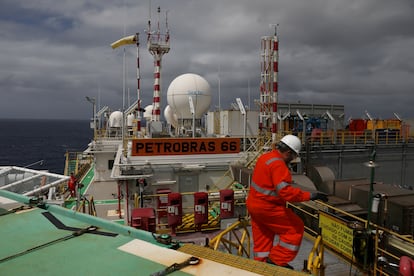Spain doubles crude purchases from Latin America to fill the Russian void
Brazil’s sales grow by a third, Mexico’s increase almost 50% and Colombia quadruples its shipments. Venezuela, Ecuador and Trinidad and Tobago went from not selling any last year to reaching the Spanish market

Spain already has a new supplier of crude oil: Latin America. In the first four months of the year, oil imports from the west shore of the Atlantic covered almost half of national needs. The increase is especially strong in the case of Central and South American countries, where imports grew by 115% in the first four months of the year, according to data published this Monday by Spain’s Corporation of Strategic Reserves of Petroleum Products (CORES).
In just one year, after the Russian invasion of Ukraine, Spain has gone from buying 700,000 tons of Russian crude to not buying any. On the opposite side, oil purchases from Venezuela, Ecuador and Trinidad and Tobago have gone from zero to 258,000, 148,000 and 101,000 tons, respectively. Colombia, for its part, has sold 586,000 tons to Spanish importers between January and April, four times more than in the same period of the previous year. And Brazil has seen shipments grow to just over two million tons, compared to 1.5 million in the first four months of 2022.
Mexico, the main origin
At a somewhat more northerly latitude, already in North America, Mexico sold over 2.7 million tons to Spain between January and April, almost 46% more than the previous year. This increase makes it the leading Spanish supplier of crude oil, ahead of two giants: the United States (2.2 million tons) and Brazil (2 million).
It is not strange that Russian and Latin American oil are interchangeable. Both are, grosso modo, of the same type: heavy, ideal for the production of so-called middle distillates, such as diesel or aviation kerosene, the segment most impacted by the ban on Russian oil derivatives. Only a few Central Asian countries —such as Azerbaijan— can compete in that segment. The rest of the world puts a lighter crude on the market, essential in the mix but not interchangeable. The versatility of the eight Spanish refineries, capable of processing all kinds of crude oil, is essential to enable this change in the importing matrix.
Imports from Africa, the Middle East and the rest of Europe fall
Purchases from Africa, on the other hand, fell by 26%, with strong setbacks in all countries except Angola, from where they rose seven-fold. And those from both the Middle East and the rest of Europe and Eurasia contracted by 14%, with the only exceptions being Norway, Kazakhstan and the aforementioned Azerbaijan.
Between January and March 2023, Spanish crude oil imports grew a meager 0.3%. In the last 12 months, however, they have risen by just over 7%. The increase is explained both by the greater internal demand for gasoline and kerosene, and by the greater Spanish exports of fuels —especially diesel— to the rest of Europe after the definitive ban on Russia.
Sign up for our weekly newsletter to get more English-language news coverage from EL PAÍS USA Edition
Tu suscripción se está usando en otro dispositivo
¿Quieres añadir otro usuario a tu suscripción?
Si continúas leyendo en este dispositivo, no se podrá leer en el otro.
FlechaTu suscripción se está usando en otro dispositivo y solo puedes acceder a EL PAÍS desde un dispositivo a la vez.
Si quieres compartir tu cuenta, cambia tu suscripción a la modalidad Premium, así podrás añadir otro usuario. Cada uno accederá con su propia cuenta de email, lo que os permitirá personalizar vuestra experiencia en EL PAÍS.
¿Tienes una suscripción de empresa? Accede aquí para contratar más cuentas.
En el caso de no saber quién está usando tu cuenta, te recomendamos cambiar tu contraseña aquí.
Si decides continuar compartiendo tu cuenta, este mensaje se mostrará en tu dispositivo y en el de la otra persona que está usando tu cuenta de forma indefinida, afectando a tu experiencia de lectura. Puedes consultar aquí los términos y condiciones de la suscripción digital.
More information
Archived In
Últimas noticias
Most viewed
- Sinaloa Cartel war is taking its toll on Los Chapitos
- Oona Chaplin: ‘I told James Cameron that I was living in a treehouse and starting a permaculture project with a friend’
- Reinhard Genzel, Nobel laureate in physics: ‘One-minute videos will never give you the truth’
- Why the price of coffee has skyrocketed: from Brazilian plantations to specialty coffee houses
- Silver prices are going crazy: This is what’s fueling the rally











































